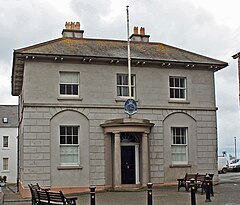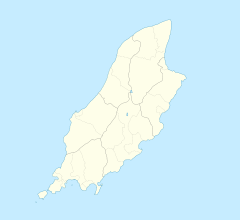Old House of Keys
| Old House of Keys | |
|---|---|

Facade of the Old House of Keys
|
|
|
Location with the Isle of Man
|
|
| General information | |
| Town or city | Castletown |
| Country | Isle of Man |
| Coordinates | 54°4′24.2″N 4°39′7.5″W / 54.073389°N 4.652083°W |
| Current tenants | Manx National Heritage (museum) |
| Construction started | 31 May 1819 |
| Completed | January 1821 |
| Cost | £1039-10-0d |
| Client | Duke of Atholl |
| Owner | House of Keys |
| Design and construction | |
| Architect | Thomas Brine |
| Website | |
| Official website | |
The Old House of Keys (Manx: Shenn-thie y Chiare as Feed) is the former meeting place of the House of Keys, the lower house of Tynwald, the Isle of Man's parliament. It is located across the street from Castle Rushen in Castletown, the former capital of the Isle of Man, in the south of the island. The building was used as the House of Keys from 1821 until 1874, when the parliament was moved to Douglas.
Prior to 1821, the House of Keys had no official home, but met first at Castle Rushen, and later at the Bishop of Sodor and Man's library in Castletown. After criticism from a Royal Commission, plans were drawn up for a new meeting house for the Keys in 1813, but after concerns about the cost, they were redrawn and approved in 1819. The building, designed by Thomas Brine, was completed in 1821. It housed the House of Keys until 1874, when the Keys followed the other primary functions of the island and moved to Douglas. After their move, the Old House became a branch of Dumbell's Bank, and later Parr's Bank. In 2000, Manx National Heritage acquired the building and began restoring the house to how it appeared in 1866. The building opened to the public as a museum in November 2001.
The parliament of the Isle of Man—Tynwald—is the oldest currently running parliament in the world. It is generally considered to have its origins in the 10th century, but could date back as far as the 8th century. Originally a 32-member Tynwald ruled over the Kingdom of the Isles, with half of its representatives coming from the Isle of Man. In the 12th century, this dropped to a 24-member Tynwald when the islands of Mull and Islay were lost to Argyll. By the 16th century, Tynwald consisted of an upper and a lower house; the lower house was known as the 24 Keys. At that time, the members met irregularly at Castle Rushen, when called upon by either the Lord of Mann or one of his Deemsters to help with legal and taxation issues. The Keys continued to meet at Castle Rushen until 1710, when they moved to Thomas Wilson's (the Bishop of Sodor and Man) library in Castletown. Late in the 18th century they still met in the library, of which a Royal Commission reported that "...the Keys assemble in a mean decayed building little more than sufficient to contain the number which they consist."
...
Wikipedia

